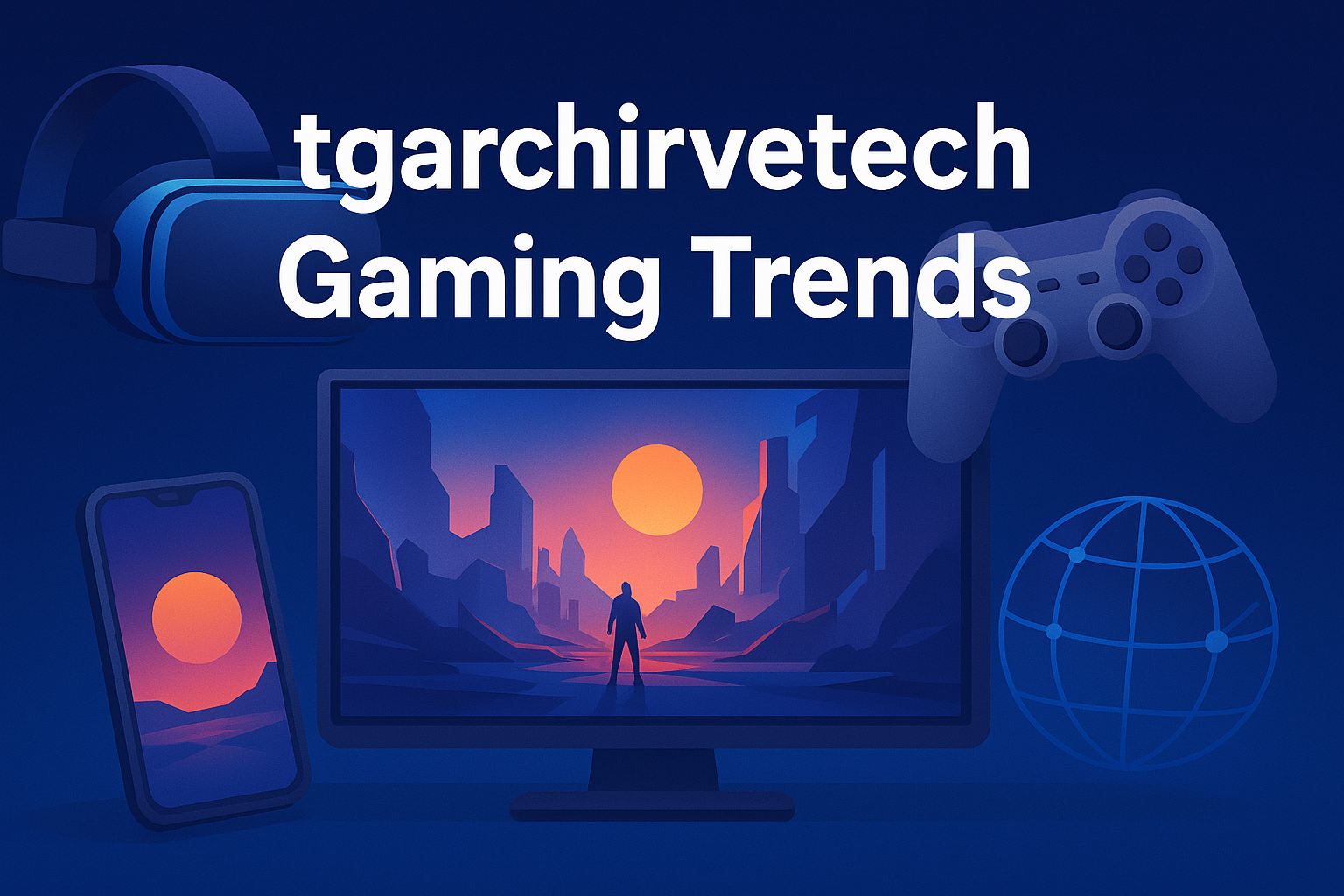The gaming industry has always been an ever-changing landscape, adapting to new technologies and cultural movements. The phrase tgarchirvetech gaming trends represents more than just a buzzword—it embodies the blending of technology, architecture, creativity, and interactive entertainment. As gaming continues to break records in global revenue, reach wider audiences, and influence popular culture, understanding these trends is key to predicting the future of digital entertainment.
Over the past decade, the industry has evolved from simple pixelated adventures into hyper-realistic, immersive worlds powered by advanced hardware, artificial intelligence, and cloud technology. Today, tgarchirvetech gaming trends capture the spirit of this transformation by pointing to the innovations that are reshaping how games are played, shared, and monetized.
The Shift Toward Immersive Worlds
One of the most notable tgarchirvetech gaming trends is the evolution of immersive environments. Virtual reality (VR) and augmented reality (AR) have become mainstream, allowing players to move beyond flat screens and interact with games in three-dimensional spaces. Companies like Meta, Sony, and Valve are pushing VR headsets with higher resolutions, lighter designs, and realistic haptic feedback systems that make the digital world feel tangible.
AR, on the other hand, merges real and digital worlds, as seen in popular titles like Pokémon GO. The blending of physical spaces with digital elements shows how tgarchirvetech gaming trends redefine interactivity, creating a future where gaming is no longer limited to the living room or desktop—it becomes part of daily life.
Cloud Gaming and the End of Hardware Barriers
Another pillar of tgarchirvetech gaming trends is cloud-based gaming. Traditional gaming often required expensive hardware upgrades, from consoles to high-end PCs. Cloud gaming platforms like Xbox Cloud Gaming, Nvidia GeForce Now, and PlayStation Plus remove these limitations by allowing players to stream games directly over the internet.
This democratization of gaming means that more people can enjoy premium titles without investing in costly hardware. In developing regions where access to gaming consoles is limited, cloud gaming is creating opportunities for millions of new players. This trend reflects a core element of tgarchirvetech gaming trends—making gaming more inclusive, scalable, and accessible worldwide.
Artificial Intelligence and Dynamic Storytelling
Artificial intelligence is revolutionizing the way games are designed and experienced. In the context of tgarchirvetech gaming trends, AI brings adaptability, smarter NPCs, and storylines that evolve based on player choices.
For example, advanced AI algorithms can learn a player’s strategies and adjust enemy difficulty accordingly, creating a more balanced challenge. Games are also beginning to incorporate procedural storytelling, where narratives branch out depending on how gamers interact with the world. Instead of static, linear plots, players can experience unique journeys crafted by AI-driven engines.
This personalization ensures that no two playthroughs feel the same, which keeps players engaged for longer and increases the emotional connection to the game.
Social Connectivity and Community-Driven Experiences
Gaming has become a social phenomenon, far beyond its early roots as a solitary pastime. One of the defining tgarchirvetech gaming trends is the rise of social connectivity in gaming. Online multiplayer, live-streaming platforms, and global tournaments have transformed games into shared experiences.
Titles like Fortnite, Roblox, and Minecraft double as digital hangout spots where players attend concerts, build collaborative projects, and socialize in creative ways. These games have evolved into ecosystems where communities thrive, influencing trends both inside and outside the gaming world.
Streaming platforms such as Twitch and YouTube Gaming have also turned players into entertainers, building audiences of millions. This symbiosis between games and social platforms is a cornerstone of tgarchirvetech gaming trends, emphasizing how community engagement is as important as the gameplay itself.
Blockchain Technology and Digital Ownership
Blockchain and NFTs remain controversial but significant in shaping tgarchirvetech gaming trends. By allowing players to own digital assets such as skins, characters, or in-game land, blockchain introduces new models of value within gaming ecosystems.
Play-to-earn models, where gamers can generate income by participating in digital economies, have already gained traction. Although some critics argue that this trend commodifies play, supporters highlight the opportunities it brings for players to have financial control over their time and digital assets.
Whether embraced widely or not, blockchain technology signals an important shift in how players perceive the worth of their in-game experiences.
Esports as a Cultural Movement
Esports are no longer a niche hobby—they are now a global industry. With professional players, billion-dollar sponsorships, and stadium-sized events, esports epitomize how tgarchirvetech gaming trends extend beyond entertainment into mainstream culture.
Titles like Counter-Strike 2, Valorant, and League of Legends have built massive fan bases, with global tournaments watched by millions. Esports athletes are treated like celebrities, and brands are heavily investing in the industry. The rise of esports proves that competitive gaming is here to stay, reshaping not just the gaming industry but also sports culture at large.
Mobile Gaming: The Power of Portability
Mobile gaming continues to dominate the industry, and it plays a central role in tgarchirvetech gaming trends. With smartphones becoming increasingly powerful, mobile games now deliver console-quality graphics, seamless online multiplayer, and innovative gameplay mechanics.
Games like PUBG Mobile, Call of Duty Mobile, and Genshin Impact illustrate how mobile platforms have become the primary gateway to gaming for billions worldwide. Mobile gaming also intersects with social connectivity, as these games often integrate chat systems, live events, and cross-platform play.
The convenience and accessibility of mobile devices ensure that mobile gaming will remain a major driver of industry growth.
The Future of tgarchirvetech Gaming Trends
Looking ahead, tgarchirvetech gaming trends suggest a future of even deeper immersion and interactivity. Mixed reality, combining AR and VR, will expand the possibilities of virtual environments. Artificial intelligence will become even more advanced, offering fully adaptive worlds that feel alive and responsive.
Meanwhile, 5G technology will make streaming and cloud gaming smoother, allowing players to experience high-quality games on the go. Community-driven development, where players influence the design of games through feedback and collaboration, will likely become more common.
Inclusivity and diversity will also shape the future of gaming. As gaming reaches every corner of the globe, developers will need to cater to a wider range of cultural perspectives, play styles, and accessibility needs.
Read also: Everything You Need to Know About 183.63.127.22
Conclusion
The gaming industry is experiencing a golden age of innovation, and tgarchirvetech gaming trends represent the essence of this transformation. From immersive VR environments and AI-driven storytelling to social ecosystems and competitive esports, gaming has grown into a cultural force that touches nearly every aspect of modern life.
As technology continues to advance, the boundaries between the real and digital worlds will blur further. What was once considered futuristic is quickly becoming part of everyday gaming experiences. The future of tgarchirvetech gaming trends is not just about playing—it is about connecting, creating, and living in worlds where imagination meets technology.


